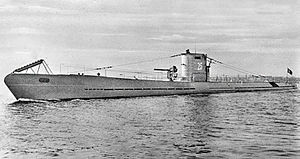 U-25, a Type I U-boat.
| |
| Class overview | |
|---|---|
| Builders | Deschimag, Bremen |
| Operators | |
| Preceded by | Spanish Type E1 |
| Succeeded by | |
| Cost | 4,500,000 ℛ︁ℳ︁ |
| In commission | 1936 – 1940 |
| Planned | 2 |
| Completed | 2 |
| Lost | 2 |
| General characteristics | |
| Displacement |
|
| Length | 72.39 m (237 ft 6 in) |
| Beam | 6.21 m (20 ft 4 in) |
| Draft | 4.30 m (14 ft 1 in) |
| Propulsion |
|
| Speed | |
| Range |
|
| Test depth | 200 m (660 ft) |
| Complement | 4 officers, 39 enlisted |
| Armament |
|
The Type I U-boat was the first post–World War I attempt to produce an oceangoing submarine for Nazi Germany's Kriegsmarine. The type was based on the Spanish Type E-1[1] and Finnish CV707, which were both designed by Ingenieurskantoor voor Scheepsbouw.[2] Only two Type IAs were built.[3] They were not a successful design : due to its single rudder they had a large turning circle and were not very manoeuvrable. The gravity center of the U-boat was too forward so on the surface the type I had its propellers exposed when she was pitching. Whilst submerged there were problems with depth keeping and stability as air bubbles in the fuel tanks wobbled back and forth. Diving was very slow: at full speed and with six tons of negative buoyancy it took forty seconds to reach ten metres depth. As a result, the type was discontinued and the new type IX class of ocean-going U-boats was designed.[4]
- ^ Gröner 1991, p. 39.
- ^ Rössler (2001), pp. 98-99.
- ^ Showell (2006), p. 73.
- ^ Paterson 2003, p. x-xi.